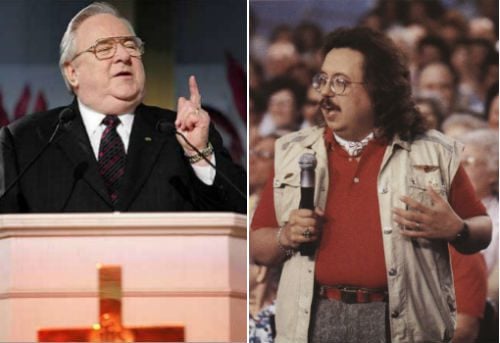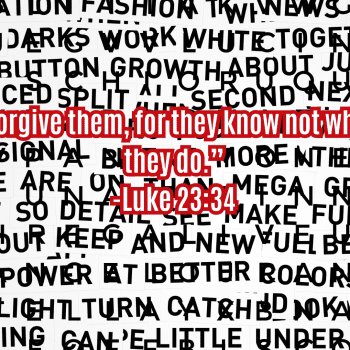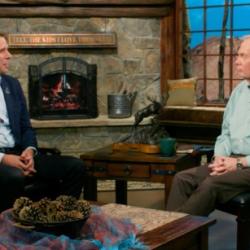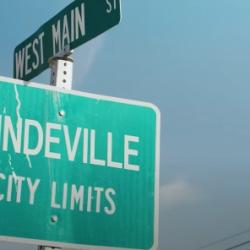Anyone who remembers the white evangelical subculture of the 1970s and 1980s will enjoy and squirm in equal measure when reading Chaplain Mike’s rapid-fire reminiscence “My So-Called Evangelical Life,” posted last month at Internet Monk. It’s the sort of thing that produces both the occasional delighted “Ooh — I remember that!” as well as the occasional wincing “Ewww — I remember that!”
It kind of makes me wish for an evangelical version of VH-1’s “I Love the ’80s.” For panelists, we could get, like, Steve Taylor, Amy Grant, Frank Schaeffer, Molly Worthen, David Dark and Sarah Masen, Barry Taylor, and of course Michael Ian Black (who, as far as I know, doesn’t know anything about the evangelical subculture, but apparently you can’t do one of those shows without him).
I want to quibble with one point in the good Chaplain’s narrative, though, which he conveys in this section:
Of course, 1980 was the year that brought us President Ronald Reagan, the first president to use “God bless America” in a major speech (except for one time when Richard Nixon was trying to save his butt during Watergate). Steven Miller observes that Reagan “was more an evangelical’s president than an evangelical president,” but that didn’t stop Jerry Falwell from proclaiming that Reagan was “the greatest thing that has happened to our country in my lifetime.” This, despite the fact that evangelicals saw few actual substantive policy changes amid an abundance of symbolic actions and gestures. Still, their leaders and spokespersons had unprecedented access to the halls of power, and that was heady stuff.
A new set of political issues and interest groups were also formed in the 1970′s, becoming more focused in the 1980′s. The Equal Rights Amendment. Abortion. Homosexuality and the AIDS epidemic. Issues like these pitted the Moral Majority, Eagle Forum, and Concerned Women for America vs. the ACLU, People for the American Way, and the National Organization for Women. Republican vs. Democrat was taking on new meanings. Culture War lines were being etched ever deeper in the sand.
But battles that were more personal and “spiritual” also got our culture’s attention in those decades.
The rise of charismatic Christianity and talk of “spiritual warfare,” along with movies like The Exorcist, fueled a new dualistic supernaturalism among Americans. This was given credibility when we watched the news and witnessed the evil, grisly acts of murderous cults like the Manson “Family” and Jim Jones and the People’s Temple (Jonestown). A “satanic panic” arose in the 1980′s fueled by revelations of “repressed memories” indicating that large numbers of children had been subjected to Satanic ritual abuse (SRA). A new diagnosis of Multiple Personality Disorder looked a lot like demon possession. Christian comedian Mike Warnke made a meteoric rise to popularity, with outrageous claims of having been delivered from Satanism. He told stories that scared the pants off Christian parents and youth alike who flocked to hear him speak and to buy his books and recordings. Preachers engaged in a focused critique on rock music’s occult influence on young people, especially in the “heavy metal” genre. These years saw the rise of the “New Age” movement. Popular Christian fiction writer Frank Peretti wrote best-selling books about “spiritual warfare against a vast, seductive New Age conspiracy” that was taking place in towns like yours and mine.
That’s good stuff. He pulls together a bunch of things that belong together — making some important connections and associations in this litany of cultural milestones and touchstones.
My quibble, though, is with that second-to-last paragraph, wherein he breaks some of those connections and associations by making a distinction between white evangelicals’ rise to political power in the Reagan years and “battles that were more personal and ‘spiritual.'” Those things were not really distinct.

The rise of the religious right didn’t just change white evangelical politics, it changed white evangelical religion — reshaping the personal and spiritual as well as the more obviously political. We went from being a people centered on and defined by a passion for evangelism to being a people centered on and defined by our political opposition to abortion. In the vocabulary of CM’s pop-cultural review, we changed from The Jesus Movie to The Silent Scream.
That accounts for Mike Warnke’s meteoric popularity and that accounts, I believe, for the Satanic Panic. Both of those accompanied the sudden ascendance of anti-abortionism as the defining characteristic of white evangelicalism.
It happened like this: Rather suddenly — in about a decade — white evangelical politics, identity, piety and dogma were rewritten and recentered around the assertion that a wicked Other was murdering babies.
Toward the end of that decade, a con-man comedian became one of the top-selling white evangelical recording artists by concocting grisly horror stories about wicked Others who murdered babies. Toward the end of that decade, a moral panic swept the country, driven by a fear of a shadowy conspiracy of, yes, wicked Others who murdered babies.
It doesn’t take a big stretch to imagine a causal connection between the rise of politicized anti-abortion religion and the rise of Warnke and the Satanic Panic that followed soon after.
It takes an implausibly big stretch of the imagination to think there is no such connection.
Our politics and our religion were reshaped and redefined as opposition to Satanic baby-killers. Then Mike Warnke came along, making a fortune by tapping into white evangelicals’ insatiable appetite for tales of Satanic baby-killers. Then fear of Satanic baby-killers wreaked havoc in schools and daycare centers and communities across the country, putting innocent people in prison for decades.
The distinction is not that anti-abortion religion is “political” while Warnke and the Satanic Panic were “personal and spiritual.” The only meaningful distinction is that, in the case of Warnke and the Satanic Panic, we have subsequently admitted that the vast conspiracy of Satanic baby-killers were a figment of our imagination — nothing more than a projection of our darkest fears and our self-righteous pride. But when it comes to anti-abortion religion, white evangelicals still refuse to admit that.
















